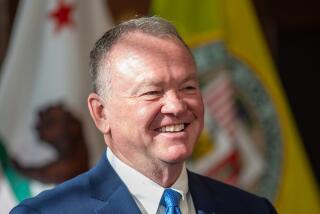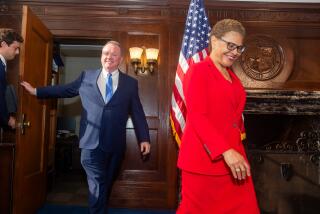Picking a new chief
There was a time in the not very distant past when the Los Angeles Police Department was about as popular with some city residents as U.S. troops are with the people of Baghdad. It was accountable only to itself, and home to far too many officers who savagely beat suspects, planted evidence, stole cocaine from evidence lockers or extorted money from drug dealers. It’s a tribute to Chief William J. Bratton that such problems -- though many came to light only a decade ago when the Rampart scandal shocked the city -- now seem like ancient history. Yet Bratton is about to become history himself, at least as far as L.A. is concerned.
Bratton’s departure at the end of October, when he will leave to join a private security firm in New York, presents a major test for the city’s Police Commission and Mayor Antonio Villaraigosa. If they are to avoid an unpleasant return to the past, they’ll have to sidestep political forces that have prompted poor choices by their predecessors. Fortunately, thanks to Bratton, they’re in a strong position to pick a chief based on his or her competence rather than politics.
The search is being conducted by the city’s personnel department, which is slated to submit the names of about a dozen top contenders to the Police Commission in early October. Meanwhile, residents get to put in their two cents: On Wednesday, the commission will hold the third of five meetings across the city to query Angelenos about what qualities they desire in a police chief. At the end of the process, the commission will submit its top three picks to Villaraigosa, who will make his choice, subject to approval by the City Council.
It wasn’t always done this way. Before 1992, picking a police chief resembled a university admissions system more than a political contest. Applicants were tested via civil service exams. The Police Commission then chose from among the top scorers. Once hired, the chief enjoyed civil service protection that insulated him from discipline or firing without “good and sufficient cause.” It wasn’t until 1991 that it became clear how dangerous it was to make a police chief so unaccountable to the public. In the wake of the Rodney King beating, Mayor Tom Bradley demanded Chief Daryl F. Gates’ resignation, but Gates refused. Without legal cause to fire the chief, Bradley’s hands were tied. He and Gates eyed each other suspiciously for more than a year without speaking; when the riots erupted in 1992, the city’s top leaders were out of touch with one another. The city paid the price.
An unrepentant Gates is among those who still believe it’s vital to insulate the police from political control. We couldn’t disagree more, but there’s no denying that civilian oversight of the LAPD in the post-Gates era has had a mixed record.
After Gates finally retired and L.A. voters approved a charter amendment that changed the way chiefs were chosen and supervised, the city turned to a man who seemed born to heal the many rifts exposed by the King beating and riots. Philadelphia Police Commissioner Willie L. Williams was the first chief in 40 years to come from outside the LAPD, at a time when many thought an insider couldn’t possibly change the department’s casual racism and easy brutality. He was a savvy politician who wasted little time reaching out to the city’s assorted constituencies. And, most important, he was African American, a vital component for reducing tensions in L.A.’s black community.
He was also a terrible manager. Williams undercut his key subordinates, failed to implement the community policing strategies he promised and was repeatedly caught telling embarrassing lies -- to journalists, City Council members and the Police Commission. Most important, he failed to implement major recommendations of the Christopher Commission, which had suggested profound changes to the LAPD’s practices and management intended to avoid a repeat of the King incident. Under his watch, the poisonous culture that came to light in 1998’s Rampart scandal festered.
Williams’ replacement, once again, seemed a match made in political heaven. Bernard C. Parks was also black, thus defusing anger over the ouster of a black chief popular in the African American community. In most other ways, he was Williams’ polar opposite: a strong disciplinarian, an LAPD insider, a straight shooter whose focus on using statistical measures to hold senior officers accountable was enormously appealing to businessman-turned-Mayor Richard Riordan. Yet by the time Parks’ term expired in 2002, Riordan’s successor, James K. Hahn, was thoroughly tired of him. Parks was a far better and more honest chief than Williams, but he feuded with top city and county leaders and fended off outside attempts to review the Rampart scandal. The Justice Department was among the agencies unimpressed, and it forced on the LAPD a consent decree over Parks’ objections.
In fact, it was the consent decree that supplied the political context for Bratton’s appointment. Bratton already was a member of the monitoring team brought in to oversee the decree, so he had inside knowledge of the LAPD as well as national credentials. He was an easy pick to revamp the post-Parks department.
The racial politics that tinged past decisions on a new chief have now largely subsided. That’s probably because the racial makeup of the LAPD has changed dramatically. Parks diversified the department, and Bratton continued that work, heavily recruiting from minority communities. Today, the men and women in blue look a lot like the people in the neighborhoods they patrol. Under Bratton, scandals have been few, crime has declined and the department’s popularity has soared. There is no public outcry for a tailor-made police chief.
That’s not to say Villaraigosa won’t be exposed to political pressures. There’s reason to worry that a mayor deeply beholden to union interests will be overly accommodating to the demands of the Police Protective League, which has blocked efforts to improve public accountability for officers at every turn. If the mayor is wise, he’ll pick a chief who’s as much like the last one as possible.
More to Read
Sign up for Essential California
The most important California stories and recommendations in your inbox every morning.
You may occasionally receive promotional content from the Los Angeles Times.










